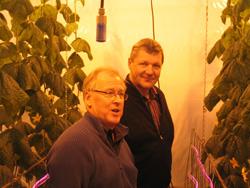 23 June 2009, Tampere - TAMK University of Applied Sciences in Tampere, Finland, has developed a unique warp knitted textile based lighting system intended for use in commercial greenhouses. The light required by the plants is produced by means of LED technology and is placed between the rows of plants. It is estimated that in the future the method will achieve savings of up to one half of the present vast need for energy in hothouses.
23 June 2009, Tampere - TAMK University of Applied Sciences in Tampere, Finland, has developed a unique warp knitted textile based lighting system intended for use in commercial greenhouses. The light required by the plants is produced by means of LED technology and is placed between the rows of plants. It is estimated that in the future the method will achieve savings of up to one half of the present vast need for energy in hothouses.
The curtain of light between the rows of plants is an idea cultivated by Matti Horppu, a lecturer at TAMK University of Applied Sciences and Esa Kivioja, Managing Director of the KKK-Vihannes Oy, a grower of organic tomatoes. The use of the curtain has been piloted in the cultivation of cucumbers.
The curtain of light developed by TAMK has been internationally patented and a utilization model has been registered in Finland. It is based on low-energy LED technology and it is currently being piloted by newly formed company Netled OY, which holds the utilization rights to the curtain and aims to commercialize it. The company says that there is market potential for the curtain of light in the Nordic countries and in Canada due to a significant period of darkness and also in central Europe.
The curtain of light makes it possible to provide the light required for plant growth with much lower consumption of electricity than with the current high-pressure sodium lamps. The power of the light in the LED of the curtain and the colour temperature can be adjusted to optimal and according to recent research it has been estimated that a plant prefers to use a different colour temperature during its growth phase than at the time of bearing fruit.
Netled says that, thanks to the curtain of light, the lighting, heating and ventilation in hothouses can be achieved more easily than with present systems. High-pressure sodium lamps require sturdy support structures, cables and transformers. Moreover, their lifespan is only a third of the life of LED lights.
Speaking at last week’s Techtextil show in Frankfurt, Matti Horrpu said: “It is planned to make the curtain of light into a warp knitted net structure which will permit air to circulate among the plants. The curtain and its LEDs are to be about one metre wide between the rows of plants and could be easily rolled up when the plants and the building need maintenance work. For example, a hothouse with floor space of around 2 hectares would require some 12 kilometres of LED curtain.”
“That same 2-hectare hothouse planting at present requires 8,000 400-watt high-pressure sodium lamps, thus the overall efficiency of the lighting is no less than 3.2 megawatts. Nevertheless, only 10 per cent of the energy from the lamps turns into light and even of this the lion’s share does not directly shine on the growing surfaces of the leaves. All this energy mounts up to an annual energy bill of about half a million Euros per year”, Horppu added.
Horrpu explained that high-pressure sodium lamps have a high surface temperature and if placed between the rows of plants they cause burn damage to leaves and fruit. If placed high up such lamps give off a lot of heat, making it difficult to maintain a steady growing temperature of 16 to 20 degrees centigrade and economical channelling of the air flow.
Horrpu says that the curtain of light is also estimated to be of use in due course in the cultivation of flowers and due to its versatile light colour capacity also in decorative and interior lighting. The method is also suitable for cultivation without day light (cave cultivation) of lettuce and herbs in densely built-up areas. The development of the curtain has been a part of TAMK’s research and development work and it has been funded by amongst others, the Finnish Funding Agency for Technology and Innovations (Tekes). Those participating in the development work included KKK-Vihannes Oy of Honkajoki which produces 700 tons of organic tomatoes annually.
Related News
Photos
More>>trade
market
- Finding trustworthy partnerships is key in today's apparel industry
- Spain: First signs of domestic retail recovery; China still an attractive market
- Red Carter at the Mercedes Benz Miami Fashion Week in Miami Beach
- Coolmax with wool for Nike Golf
- Luca Carati brings diamonds to life with its Elizabeth Collection





